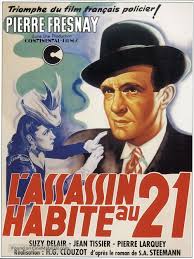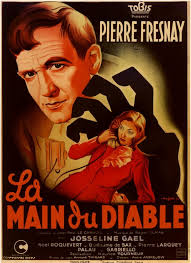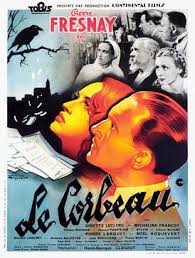L’Assassin habite au 21 (1942) The Murderer Lives at No. 21. IMDB meta-data is a runtime of 1 h 24 m rated 7.3 by 3,700 cinematizens.
La main du diable (1943) The Carnival of Sinners (The Hand of the Devil). IMDB meta-data is a runtime 1 h 20 m rated 7.3 by 1,800 cinematizens.
Le Corbeau (1943) The Crow. IMDB meta-data is a runtime 1 h 43 m, rated 7.8 by 11,000 cinematizens.
DNA: France occupée (1940-1944).
Genre: Noir.
These three films, among others, were made by Continental Studios during the German Occupation of France, each of the trio starred Pierre Fresney and were directed by Henri-Georges Clouzot, credited or not. They were united in another way, too, after the Liberation, all of them, but especially Le Corbeau (The Crow) were banned. Why? Each showed France, French society and people in a bad light.
This social criticism of France by Studios managed (very loosely as it turned out) by Germans, got Clouzot and Fresnay ostracised (and briefly imprisoned) along with the co-star in two of the movies, Suzy Delair. However, cooler and wiser heads prevailed and the ban was lifted quickly.
This background reminds us that the producer and director did not have a free hand in these labours. Indeed, even at this distance it is impossible to watch these three individually or in seriatim without seeing a watermark of the Occupation, but as a covert critique rather than an overt affirmation. Read on.

In L’Assassin habite a boarding house’s inhabitants, men and women, are examined in the search for a serial killer. The vanities, foibles, pretexts, dissimulations, vices, incompetences of each is laid bare as the detective (posing as a roomer) moves among them. (Jules Maigret used this vantage point in Madame Quatre et ses enfants, the film version of which in 1991 is discussed elsewhere on the blog for clickers.) Suffice it to say there is more than one murderer at numero 21. It is an allegorical tale of what France has now become in 1942: Schemers, spies, thieves, cheats, and liars. Nothing is as it seems to be because it is worse.

La main du diable is even more explicit in its analogy to the Occupation: Make a deal with the devil for the time being and discover that time never ends, as long as you live. Fresnay who played the charming and jocular detective in L’Assassin here is a tortured soul who can find no relief from his Faustian bargain. He is France occupé both cursed and blessed: blessed to be out of the war and cursed to be occupied. The only way out is death. Grim.

These two might have been forgiven and forgotten but then came Le Corbeau and no one forgets its relentless condemnation of picturesque, bucolic, rural, and eternale France as a nest of vipers, stinging each other to death. The parallel to the Occupation is obvious to any viewer at the time yet the German censors let it go. The plot engine is a campaign of poison pen letters at a time when the Occupier encouraged French citizens to denounce each other in anonymous letters just like those portrayed in the film. While Fresnay carries the film, the elder doctor played by Pierre Larquey is mesmerising at times. Watch for the scene with the swinging light fixture to see what I mean. The final act condemned the film twice over when a nun commits a murder. A nun! Is nothing sacred. Non.
Continental had a repertoire cast and they appear and reappear in these three and its thirty other films.
***
By the way many will have seen, and surely remember, Fresney from Le Grand Illusion (1937) as the world weary aristocrat who sacrifices himself to pass the baton of moral leadership onto the energies of the working class Jean Gabin.
Fresney soldiered in WWI and had his last screen credit in 1975.

